SOD Disease Maps
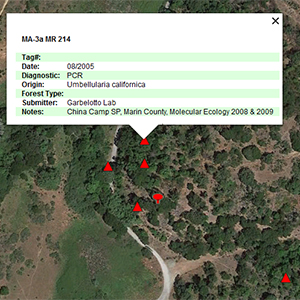
matteolab.org


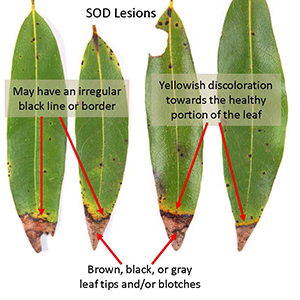

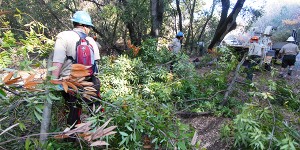
Selective removal and pruning of California bay laurel (Umbellularia californica) trees as a strategy to protect oaks and tanoaks from SOD infection.
For oaks between 3″ (8cm) and 32″ (80cm) diameter at breast height (DBH), remove small and medium sized bay laurels for a distance of 30ft (10m) around the tree. If large bays are present it may be useful to prune large branches that fall within the 30ft (10m) buffer zone. For oaks larger then 32″ (80cm) DBH, increase the bay-free buffer zone to 50-65 ft (15-20m).
Bays are persistent landscape plants that re-sprout quickly and produce lateral tillers in abundance. As a result they are difficult to remove permanently. Useful techniques include adding a spreader to the herbicide or applying the herbicide with a “hack and squirt” technique (see links below). For best results, apply the herbicide when the tree is alive, wait approximately a month for the chemicals to be distributed throughout the tree, killing the roots, and then cut it down
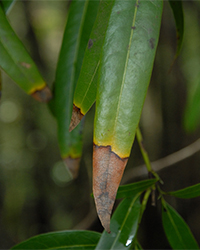
Managing the presence of bays, the primary carrier of P. ramorum, around high-value oaks and tanoaks can reduce the number of infectious spores in the environment. However, bays are important species in their own right and care must be taken not to disrupt their role in the environment, particularly along streams where they are particularly important.

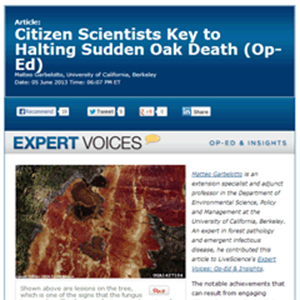


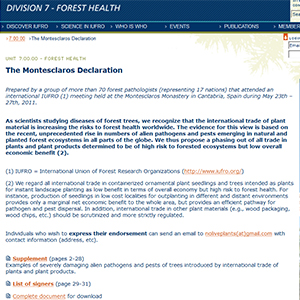
|
||
Ingrid the intern unboxes the EA-8 1200 XLS adjustable spacer E4 XLS multichannel pipette.
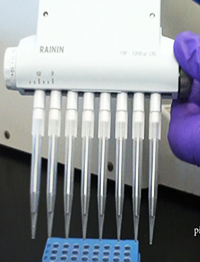 Multichannels are a huge time saver for any plate based assay; adjustable width multichannel pipettes are a levolution up. Yes, it’s a word DICE made up for BF4, but it describes the game changeyness of this pipette so we’re all just going to have to live with it. Turning the knob on the side of the pipet head rotates an internal cylindrical gear that changes the spacing between the tips. We know because we had Ingrid take it apart.
Multichannels are a huge time saver for any plate based assay; adjustable width multichannel pipettes are a levolution up. Yes, it’s a word DICE made up for BF4, but it describes the game changeyness of this pipette so we’re all just going to have to live with it. Turning the knob on the side of the pipet head rotates an internal cylindrical gear that changes the spacing between the tips. We know because we had Ingrid take it apart.
Being able to change the distance between the tips may not seem like a thing, until you have to individually pipet from a couple of hundred 1.5ml tubes into PCR plates or go from 24 well TC plates to 96 well assays. The adjustable width multichannel knocks them out 8 at a time. Also, have you ever noticed that the spacing of the teeth in your gel combs is just a couple mm off from a standard PCR plate? Not so much of a problem anymore.
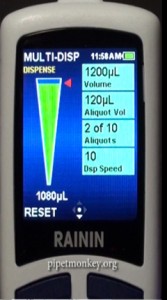 There are a lot more adjustments on the electronic version than any one person will probably ever need: liquid volume, separate aspirate and dispense speeds, mixing cycles, multi-dispense, reverse pipetting (no one in our lab knew what that one is but it’s gotta matter to somebody), dilution, titrations, and about a hundred other things that are configurable in the settings.
There are a lot more adjustments on the electronic version than any one person will probably ever need: liquid volume, separate aspirate and dispense speeds, mixing cycles, multi-dispense, reverse pipetting (no one in our lab knew what that one is but it’s gotta matter to somebody), dilution, titrations, and about a hundred other things that are configurable in the settings.
The battery life is OK; you should be able to go about a 10hr working day on one charge. Also these newer gen XLS pipettes have better ergonomics, which really matters if you are using it every day. The tip eject even seems to have a lighter touch to it, compared to older multichannels. Experienced pipetmonkeys will probably lean towards the manual models but for things like QC, GMP/GLP, or production the electronic versions could be better. Link to the operating instructions that Ingrid didn’t read and tossed on the floor (no surprise) and to the manufacturer’s website.
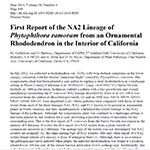
A Disease Note in the scientific journal Phytopathology records the first instance of Phytophthora ramorum, the causal agent of Sudden Oak Death, found in the Sierra Nevada foothills of California. The June 2014 article (PDF link) is the first time that the “NA2” lineage of SOD, that is usually only found in commercial nurseries, has been isolated in the wild in California. The host plant that the disease was isolated from was an ornamental rhododendron that had been planted a year earlier. Nursery plants are highly regulated and inspected for SOD in California but this discovery illustrates the need for continued efforts to prevent the spread of SOD to previously uninfected areas.